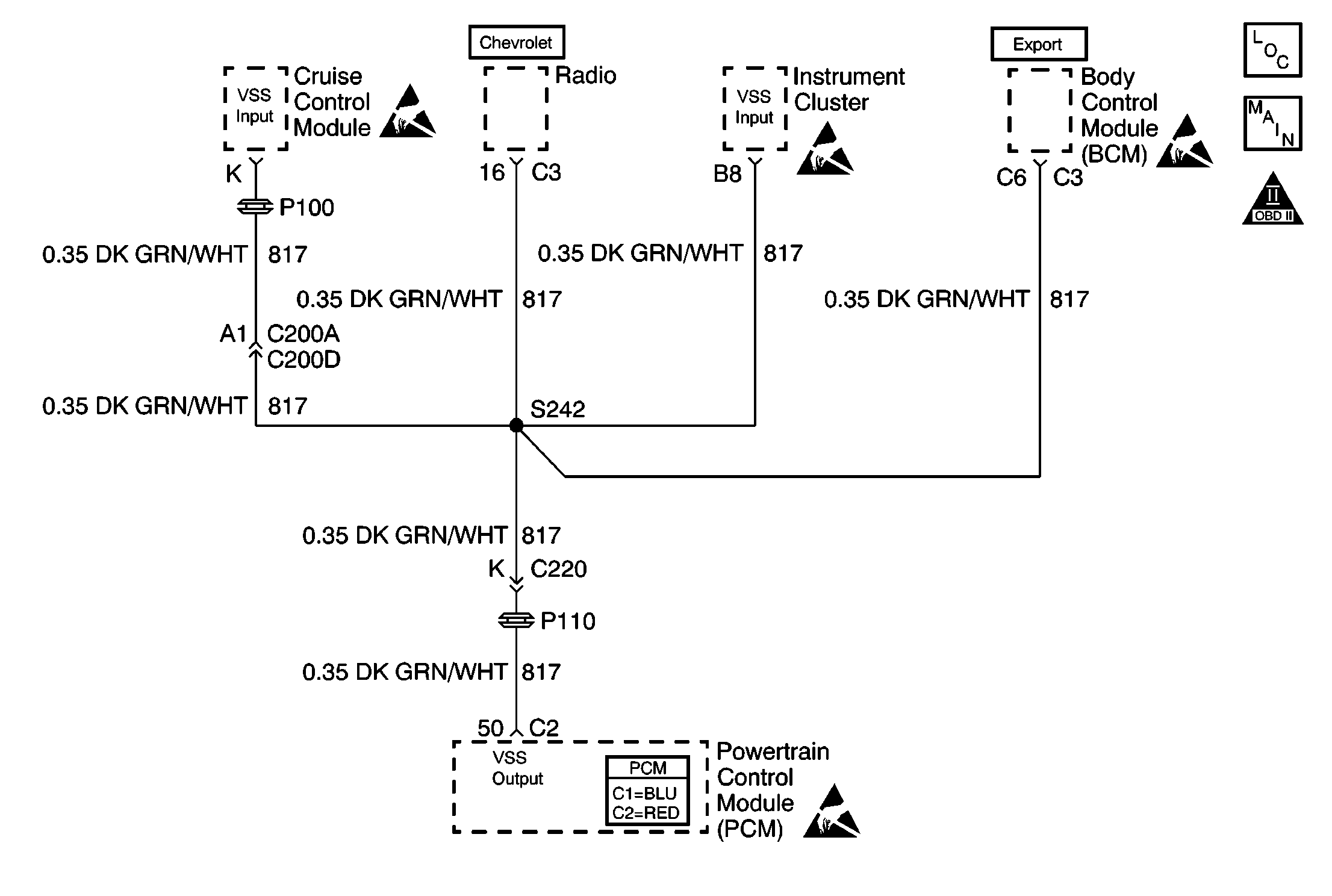
Circuit Description
Various components apply a voltage to the Vehicle Speed Output circuit. The PCM creates the Vehicle Speed Output signal by rapidly grounding this circuit via an internal switch called a driver. The driver operates at the same rate as the VSS signal input. The various components recognize the voltage being pulled to ground as an indication of vehicle speed.
The driver supplies the ground for the component being controlled. Each driver has a fault line which the PCM monitors. When the PCM commands a component ON, the voltage of the control circuit should be low (near 0 volts). When the PCM commands the control circuit to a component OFF, the voltage potential of the circuit should be high (near battery voltage). If the fault detection circuit senses a voltage other than what is expected, the fault line status changes causing the DTC to set.
Conditions for Running the DTC
| • | The engine speed is more than 400 RPM. |
| • | The ignition voltage is between 6.0 volts and 18.0 volts. |
Conditions for Setting the DTC
| • | The PCM detects that the commanded state of the driver and the actual state of the control circuit do not match. |
| • | The condition must be present for a minimum of 5 seconds. |
Action Taken When the DTC Sets
| • | The powertrain control module (PCM) stores the DTC information into memory when the diagnostic runs and fails. |
| • | The malfunction indicator lamp (MIL) will not illuminate. |
| • | The PCM records the operating conditions at the time the diagnostic fails. The PCM stores this information in the Failure Records. |
Conditions for Clearing the DTC
| • | A last test failed, or current DTC, clears when the diagnostic runs and does not fail. |
| • | A history DTC will clear after 40 consecutive warm-up cycles, if no failures are reported by this or any other non-emission related diagnostic. |
| • | Use a scan tool in order to clear the DTC. |
Diagnostic Aids
Important:
• Remove any debris from the PCM connector surfaces before servicing
the PCM. Inspect the PCM connector gaskets when diagnosing/replacing
the PCM. Ensure that the gaskets are installed correctly. The gaskets
prevent contaminate intrusion into the PCM. • For any test that requires probing the PCM or a component
harness connector, use the J 35616
connector test adapter kit. Using this kit prevents damage
to the harness/component terminals. Refer to
Using Connector Test Adapters
in Wiring Systems.
For an intermittent condition, refer to Symptoms .
Test Description
The numbers below refer to the step numbers on the diagnostic table.
Step | Action | Value(s) | Yes | No |
|---|---|---|---|---|
1 | Did you perform the Powertrain On-Board Diagnostic (OBD) System Check? | -- | ||
2 |
Does the vehicle speedometer indicate a vehicle speed? | -- | Go to Diagnostic Aids | |
Does the DMM display above the specified value? | 9.6V | |||
4 |
Does the DMM display continuity? | -- | ||
Test the continuity of the vehicle speed circuit using the DMM connected to battery ground. Refer to Testing for Continuity in Wiring Systems. Does the DMM display continuity? | -- | Go to Diagnostic System Check - Instrument Cluster in Instrument Panel, Gauges, and Console | ||
6 | Repair the open vehicle speed circuit. Refer to Wiring Repairs in Wiring Systems. Is the action complete? | -- | -- | |
7 | Repair the grounded vehicle speed circuit. Refer to Wiring Repairs in Wiring Systems. Is the action complete? | -- | -- | |
8 |
Did you find and correct the condition? | -- | ||
9 |
Important: Program the replacement PCM. Refer to Powertrain Control Module Replacement/Programming . Replace the PCM. Is the action complete? | -- | -- | |
10 | Select the Capture Info option and the Review Info option using the scan tool. Does the scan tool display any DTCs that you have not diagnosed? | -- | Go to the applicable DTC table | System OK |
